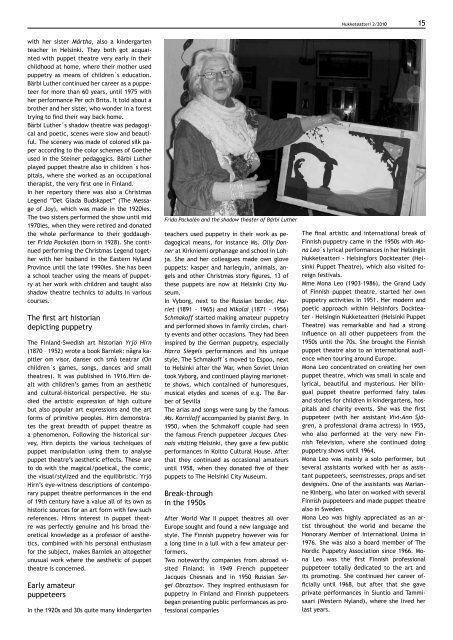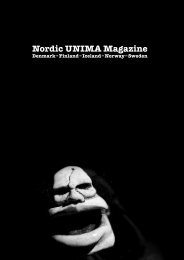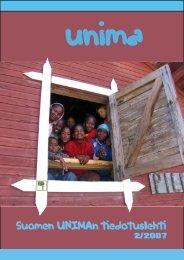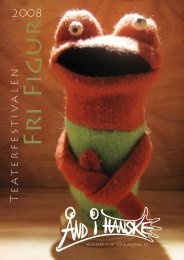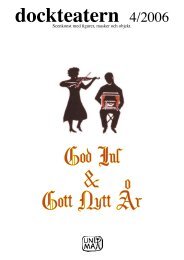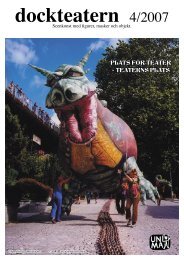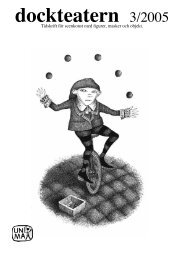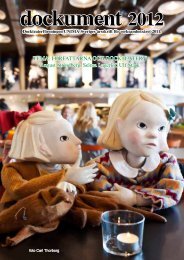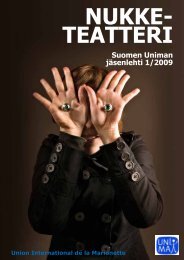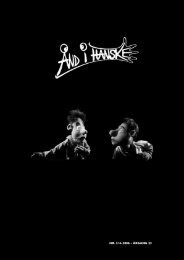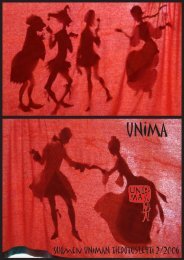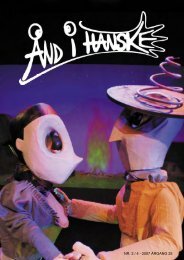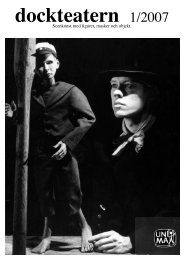Suomen Unima ry:n lehti - Unima.nu
Suomen Unima ry:n lehti - Unima.nu
Suomen Unima ry:n lehti - Unima.nu
Create successful ePaper yourself
Turn your PDF publications into a flip-book with our unique Google optimized e-Paper software.
Nukketeatteri 2/2010<br />
15<br />
with her sister Märtha, also a kindergarten<br />
teacher in Helsinki. They both got acquainted<br />
with puppet theatre ve<strong>ry</strong> early in their<br />
childhood at home, where their mother used<br />
puppet<strong>ry</strong> as means of children´s education.<br />
Bärbi Luther conti<strong>nu</strong>ed her career as a puppeteer<br />
for more than 60 years, until 1975 with<br />
her performance Per och Brita. It told about a<br />
brother and her sister, who wonder in a forest<br />
t<strong>ry</strong>ing to find their way back home.<br />
Bärbi Luther´s shadow theatre was pedagogical<br />
and poetic, scenes were slow and beautiful.<br />
The scene<strong>ry</strong> was made of colored silk paper<br />
according to the color schemes of Goethe<br />
used in the Steiner pedagogics. Bärbi Luther<br />
played puppet theatre also in children´s hospitals,<br />
where she worked as an occupational<br />
therapist, the ve<strong>ry</strong> first one in Finland.<br />
In her reperto<strong>ry</strong> there was also a Christmas<br />
Legend ”Det Glada Budskapet” (The Message<br />
of Joy), which was made in the 1920ies.<br />
The two sisters performed the show until mid<br />
1970ies, when they were retired and donated<br />
the whole performance to their goddaughter<br />
Frida Packalén (born in 1928). She conti<strong>nu</strong>ed<br />
performing the Christmas Legend together<br />
with her husband in the Eastern Nyland<br />
Province until the late 1990ies. She has been<br />
a school teacher using the means of puppet<strong>ry</strong><br />
at her work with children and taught also<br />
shadow theatre technics to adults in various<br />
courses.<br />
The first art historian<br />
depicting puppet<strong>ry</strong><br />
The Finland-Swedish art historian Yrjö Hirn<br />
(1870 – 1952) wrote a book Barnlek: några kapitler<br />
om visor, danser och små teatrar (On<br />
children´s games, songs, dances and small<br />
theatres). It was published in 1916.Hirn dealt<br />
with children’s games from an aesthetic<br />
and cultural-historical perspective. He studied<br />
the artistic expression of high culture<br />
but also popular art expressions and the art<br />
forms of primitive peoples. Hirn demonstrates<br />
the great breadth of puppet theatre as<br />
a phenomenon. Following the historical survey,<br />
Hirn depicts the various techniques of<br />
puppet manipulation using them to analyse<br />
puppet theatre’s aesthetic effects. These are<br />
to do with the magical/poetical, the comic,<br />
the visual/stylized and the equilibristic. Yrjö<br />
Hirn’s eye-witness descriptions of contempora<strong>ry</strong><br />
puppet theatre performances in the end<br />
of 19th centu<strong>ry</strong> have a value all of its own as<br />
historic sources for an art form with few such<br />
references. Hirns interest in puppet theatre<br />
was perfectly ge<strong>nu</strong>ine and his broad theoretical<br />
knowledge as a professor of aesthetics,<br />
combined with his personal enthusiasm<br />
for the subject, makes Barnlek an altogether<br />
u<strong>nu</strong>sual work where the aesthetic of puppet<br />
theatre is concerned.<br />
Early amateur<br />
puppeteers<br />
In the 1920s and 30s quite many kindergarten<br />
Frida Packalén and the shadow theater of Bärbi Luther<br />
teachers used puppet<strong>ry</strong> in their work as pedagogical<br />
means, for instance Ms. Olly Donner<br />
at Kirkniemi orphanage and school in Lohja.<br />
She and her colleagues made own glove<br />
puppets: kasper and harlequin, animals, angels<br />
and other Christmas sto<strong>ry</strong> figures. 13 of<br />
these puppets are now at Helsinki City Museum.<br />
In Vyborg, next to the Russian border, Harriet<br />
(1891 - 1965) and Nikolai (1871 - 1956)<br />
Schmakoff started making amateur puppet<strong>ry</strong><br />
and performed shows in family circles, charity<br />
events and other occasions. They had been<br />
inspired by the German puppet<strong>ry</strong>, especially<br />
Harro Siegels performances and his unique<br />
style. The Schmakoff´s moved to Espoo, next<br />
to Helsinki after the War, when Soviet Union<br />
took Vyborg, and conti<strong>nu</strong>ed playing marionette<br />
shows, which contained of humoresques,<br />
musical etydes and scenes of e.g. The Barber<br />
of Sevilla<br />
The arias and songs were sung by the famous<br />
Ms. Korniloff accompanied by pianist Berg. In<br />
1950, when the Schmakoff couple had seen<br />
the famous French puppeteer Jacques Chesnais<br />
visiting Helsinki, they gave a few public<br />
performances in Koitto Cultural House. After<br />
that they conti<strong>nu</strong>ed as occasional amateurs<br />
until 1958, when they donated five of their<br />
puppets to The Helsinki City Museum.<br />
Break-through<br />
in the 1950s<br />
After World War II puppet theatres all over<br />
Europe sought and found a new language and<br />
style. The Finnish puppet<strong>ry</strong> however was for<br />
a long time in a lull with a few amateur performers.<br />
Two noteworthy companies from abroad visited<br />
Finland: in 1949 French puppeteer<br />
Jacques Chesnais and in 1950 Russian Sergei<br />
Obraztsov. They inspired enthusiasm for<br />
puppet<strong>ry</strong> in Finland and Finnish puppeteers<br />
began presenting public performances as professional<br />
companies<br />
The final artistic and international break of<br />
Finnish puppet<strong>ry</strong> came in the 1950s with Mona<br />
Leo´s lyrical performances in her Helsingin<br />
Nukketeatteri - Helsingfors Dockteater (Helsinki<br />
Puppet Theatre), which also visited foreign<br />
festivals.<br />
Mme Mona Leo (1903-1986), the Grand Lady<br />
of Finnish puppet theatre, started her own<br />
puppet<strong>ry</strong> activities in 1951. Her modern and<br />
poetic approach within Helsinfors Dockteater<br />
- Helsingin Nukketeatteri (Helsinki Puppet<br />
Theatre) was remarkable and had a strong<br />
influence on all other puppeteers from the<br />
1950s until the 70s. She brought the Finnish<br />
puppet theatre also to an international audience<br />
when touring around Europe.<br />
Mona Leo concentrated on creating her own<br />
puppet theatre, which was small in scale and<br />
lyrical, beautiful and mysterious. Her bilingual<br />
puppet theatre performed fai<strong>ry</strong> tales<br />
and stories for children in kindergartens, hospitals<br />
and charity events. She was the first<br />
puppeteer (with her assistant Vivi-Ann Sjögren,<br />
a professional drama actress) in 1955,<br />
who also performed at the ve<strong>ry</strong> new Finnish<br />
Television, where she conti<strong>nu</strong>ed doing<br />
puppet<strong>ry</strong> shows until 1964.<br />
Mona Leo was mainly a solo performer, but<br />
several assistants worked with her as assistant<br />
puppeteers, seemstresses, props and set<br />
designers. One of the assistants was Marianne<br />
Kinberg, who later on worked with several<br />
Finnish puppeteers and made puppet theatre<br />
also in Sweden.<br />
Mona Leo was highly appreciated as an artist<br />
throughout the world and became the<br />
Honora<strong>ry</strong> Member of International <strong>Unima</strong> in<br />
1976. She was also a board member of The<br />
Nordic Puppet<strong>ry</strong> Association since 1966. Mona<br />
Leo was the first Finnish professional<br />
puppeteer totally dedicated to the art and<br />
its promoting. She conti<strong>nu</strong>ed her career officially<br />
until 1968, but after that she gave<br />
private performances in Siuntio and Tammisaari<br />
(Western Nyland), where she lived her<br />
last years.


